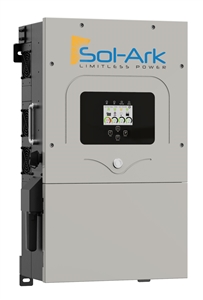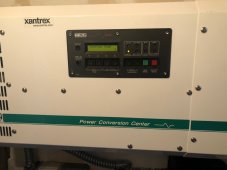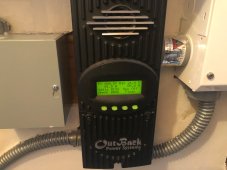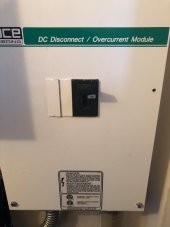Hello, I'm new to the off-grid PV/battery arena. I purchased a seasonal off-grid home that has enough power for three seasons but not for winter. I'd like to find a reasonable upgrade path and if anyone would provide assistance or thoughts that would be great!
My current setup:.
1. 10x 140w BP Solar Panels:
2. Outback FLEXmax 60 Solar Charge Controller (mine is an early version from over 15 years ago): https://www.outbackpower.com/downlo...controllers/flexmax_6080/fm6080_datasheet.pdf
3. Xantrex Trace 24v Inverter/Charger:
4. 12x Surrette Rolls S6 L16-HC (S-550) 445Ah 6V Deep Cycle Batteries:
Some pictures of my setup are attached.
All of the equipment is between 15 and 18 years old besides the batteries which are just over 2 years old. From my understanding, at that time, this was higher end equipment. On a full sun summer day, even with such old panels, I can get just over 1400w input from the solar panels as shown on the Outback solar charge controller display. I thought that was pretty impressive for the age of the equipment. By my calculations; I have about 32kWh of battery storage.
I was thinking of buying four more identical batteries to make a bank of 16. If I kept the 24v inverter, I would just put the four new ones in the space in the battery box picture where the water bottles are and connect them in parallel. My max AMP draw would be around 100, or about 2,400 watts which from my understanding is my current setups limits (and basically any proper 24v system?).
It looks like my Outback is almost maxed out (1,400w PV input and 1,500w rated max at 24v). So from my understanding, if I increase the battery bank, I could keep all the other components the same, but I really feel 1,400w PV input, especially on short winter days for a 42kWh battery bank is WOEFULLY undersized. Thoughts?
So that leads me to increasing my solar array. I have two options:
1. Do an interim setup in which I tag on two 300w panels on either end of my current PV array, for 2,000w input, upgrade the Outback to the Flexmax80 which maxes out at 2,000w at 24v, add the four Surrette batteries and keep the system 24v. That would be about $2K for the batteries, $600 for the two solar panels, and $500 for the new Outback, for a little over $3K.
2. Just go with my end-state setup desire which is 5,000 watts of solar. Now from my understanding, I would need to switch to a 48v system. So if I buy four more 6v batteries, for 16 total, I wire them for two parallel banks of 8 series batteries to get 48v? Since the voltage is doubled, I do not have to decrease the gauge of the wiring correct? Since my Xantrex inverter/charger is 24v, I would obviously need to swap that out. What is a good 48v inverter/charger? I usually only go with USA/European made stuff.
If I go down route #1 for a temporary solution; I am a little unclear on how panel voltage and the solar charge controller interact. Looking at the spec sheet of my solar panels. Is it the Voltage at Maximum Power at 34v what I am concerned with? Do the two additional solar panels I would like to add also need to be 34v? I am not at the property now so I cannot look in the junction box to see how the panels are wired, nor the gauge of the wire going to the solar controller. Since my Outback has a max PV array voltage of 150v, I assume my panels are wired in such a way with some in parallel to keep the voltage at 150v or lower. Any thoughts? How Could I add two 200 or 300 watt panels on either end and they work properly with the current panels?
Also included is a picture of the current rack system for the solar array. It looks like I may have some area on the ends that I can put another panel if I get creative with the support structure. I am pretty creative in that regard. I also noticed a gap in the middle of the array... I was curious if that was there for a particular reason, maybe to relieve wind pressure?
But my thought process if if I do go down path #1, I'm basically just wasting $3K as this is not the system I want to end up with. Only 2kW of solar isn't nearly enough once I start to live full-time in the house and have an electric vehicle that will be charged once and a while. (would also nice to have a inverter than could do 240v output).
So would adding two solar panels, upgrading the Outback from the 60 to 80 amp model, and adding 4 6v batteries be doable? Any panel recommendations?
Now if I went with option #2, I think I could peace-meal the system and upgrade as I go along. I could get rid of the 24v Xantrex inverter, get rid of the Outback, get 4 more 6v batteries, wire them for 48v and buy something like a Sol-Ark 12K.

This would allow significant future upgrades, such as switching to a large 48v lithium bank, plus expanding solar array to 5 to 6kW. From my understanding this Sol-Ark is a "do it all" device. MPPT solar charge controller, 120/240v inverter, etc?
Now the tricky part is my current PV array mounting system. Obviously that cannot support 5-6kW of solar panels. So I could buy the Sol-Ark 12K now, buy the two extra solar panels and just run 2kW of solar and the 16 battery 48v Surrette batteries and upgrade that when I move out full time.
Are there modern narrow in width solar panels that are tall and 300+ watts each? I'm thinking of how I can maximize the use of space on the current PV rack to 3kW of solar, than build an identical one for another 3kW for 6kW total. Other questions are: can 16 - 6v FLA batteries even charge fast enough for 6kW of solar input? Would it be better to switch to lithium bank? (any 240v electric car charging would only be done when the sun is shining).
I'm just looking for the most cost effective route... I'm not even sure how much longer my current equipment will last. Both my Xantrex charger/inverter and Outback solar charge controller are over 15 years old, am I already treading thin ice?
As a pretty capable mechanic/handyman, would you think me adding 4 more 6v batteries, reconfiguring the battery bank to be 48v, removing the Xantrex and Outback and installing a Sol-Ark 12K is in the reasonable realm? The other question I have is I've been reading that when you increase the PV voltage, more expensive higher cost PV fuses/breakers come into play.
The solar array is about 50 meters from the Solar charge controller, and that gauge of wire is unknown at this point. I'd imagine if it needs to be upgraded to a lower gauge, I could use the existing wire to feed the new cable through. I would also like some smart management/remote access of the systems state. Which obviously right now I cannot do. Only way I can currently monitor the voltage is to literally point a wifi security camera at the voltage read-out.
So if you had $10-$20K to play with to upgrade this system, which route would you go?
Is it a waste to spend $3K on option #1 when eventually it looks like I would need to replace it all anyway? Is it worth spending $2K for four more batteries, and save/utilize the 12 current high end FLA batteries that are only 2 years old? (I understand the four new batteries would be "dragged worn/down" by the 2 year older batteries during charging/discharging and artificially lower their lifespan). Or is going lithium really the best option? Does any of my equipment have any resale value? I'd imagine in an area like mine with a lot of off-grid, someone needs batteries at least.
I hope I wasn't droning on too much and I look forward to your thoughts and/or something maybe I missed.
My current setup:.
1. 10x 140w BP Solar Panels:
BP SX140S 140 Watt Solar Panel from BP Solar
Specs/datasheet: BP SX140S solar panel made by BP Solar has 140 watt output power with module efficiency 11.1% .
www.posharp.com
2. Outback FLEXmax 60 Solar Charge Controller (mine is an early version from over 15 years ago): https://www.outbackpower.com/downlo...controllers/flexmax_6080/fm6080_datasheet.pdf
3. Xantrex Trace 24v Inverter/Charger:
4. 12x Surrette Rolls S6 L16-HC (S-550) 445Ah 6V Deep Cycle Batteries:
Some pictures of my setup are attached.
All of the equipment is between 15 and 18 years old besides the batteries which are just over 2 years old. From my understanding, at that time, this was higher end equipment. On a full sun summer day, even with such old panels, I can get just over 1400w input from the solar panels as shown on the Outback solar charge controller display. I thought that was pretty impressive for the age of the equipment. By my calculations; I have about 32kWh of battery storage.
I was thinking of buying four more identical batteries to make a bank of 16. If I kept the 24v inverter, I would just put the four new ones in the space in the battery box picture where the water bottles are and connect them in parallel. My max AMP draw would be around 100, or about 2,400 watts which from my understanding is my current setups limits (and basically any proper 24v system?).
It looks like my Outback is almost maxed out (1,400w PV input and 1,500w rated max at 24v). So from my understanding, if I increase the battery bank, I could keep all the other components the same, but I really feel 1,400w PV input, especially on short winter days for a 42kWh battery bank is WOEFULLY undersized. Thoughts?
So that leads me to increasing my solar array. I have two options:
1. Do an interim setup in which I tag on two 300w panels on either end of my current PV array, for 2,000w input, upgrade the Outback to the Flexmax80 which maxes out at 2,000w at 24v, add the four Surrette batteries and keep the system 24v. That would be about $2K for the batteries, $600 for the two solar panels, and $500 for the new Outback, for a little over $3K.
2. Just go with my end-state setup desire which is 5,000 watts of solar. Now from my understanding, I would need to switch to a 48v system. So if I buy four more 6v batteries, for 16 total, I wire them for two parallel banks of 8 series batteries to get 48v? Since the voltage is doubled, I do not have to decrease the gauge of the wiring correct? Since my Xantrex inverter/charger is 24v, I would obviously need to swap that out. What is a good 48v inverter/charger? I usually only go with USA/European made stuff.
If I go down route #1 for a temporary solution; I am a little unclear on how panel voltage and the solar charge controller interact. Looking at the spec sheet of my solar panels. Is it the Voltage at Maximum Power at 34v what I am concerned with? Do the two additional solar panels I would like to add also need to be 34v? I am not at the property now so I cannot look in the junction box to see how the panels are wired, nor the gauge of the wire going to the solar controller. Since my Outback has a max PV array voltage of 150v, I assume my panels are wired in such a way with some in parallel to keep the voltage at 150v or lower. Any thoughts? How Could I add two 200 or 300 watt panels on either end and they work properly with the current panels?
Also included is a picture of the current rack system for the solar array. It looks like I may have some area on the ends that I can put another panel if I get creative with the support structure. I am pretty creative in that regard. I also noticed a gap in the middle of the array... I was curious if that was there for a particular reason, maybe to relieve wind pressure?
But my thought process if if I do go down path #1, I'm basically just wasting $3K as this is not the system I want to end up with. Only 2kW of solar isn't nearly enough once I start to live full-time in the house and have an electric vehicle that will be charged once and a while. (would also nice to have a inverter than could do 240v output).
So would adding two solar panels, upgrading the Outback from the 60 to 80 amp model, and adding 4 6v batteries be doable? Any panel recommendations?
Now if I went with option #2, I think I could peace-meal the system and upgrade as I go along. I could get rid of the 24v Xantrex inverter, get rid of the Outback, get 4 more 6v batteries, wire them for 48v and buy something like a Sol-Ark 12K.

Sol-Ark 12,000 Watt 48 Volt All-In-One Solar Generator - Inverter - 12K
Sol-Ark 12,000 Watt 48 Volt All-In-One Solar Generator - Inverter - 12K Â EcoDirect.com sells Magnum Inverters at the lowest cost. Order Online or Call Us! 888-899-3509
www.ecodirect.com
This would allow significant future upgrades, such as switching to a large 48v lithium bank, plus expanding solar array to 5 to 6kW. From my understanding this Sol-Ark is a "do it all" device. MPPT solar charge controller, 120/240v inverter, etc?
Now the tricky part is my current PV array mounting system. Obviously that cannot support 5-6kW of solar panels. So I could buy the Sol-Ark 12K now, buy the two extra solar panels and just run 2kW of solar and the 16 battery 48v Surrette batteries and upgrade that when I move out full time.
Are there modern narrow in width solar panels that are tall and 300+ watts each? I'm thinking of how I can maximize the use of space on the current PV rack to 3kW of solar, than build an identical one for another 3kW for 6kW total. Other questions are: can 16 - 6v FLA batteries even charge fast enough for 6kW of solar input? Would it be better to switch to lithium bank? (any 240v electric car charging would only be done when the sun is shining).
I'm just looking for the most cost effective route... I'm not even sure how much longer my current equipment will last. Both my Xantrex charger/inverter and Outback solar charge controller are over 15 years old, am I already treading thin ice?
As a pretty capable mechanic/handyman, would you think me adding 4 more 6v batteries, reconfiguring the battery bank to be 48v, removing the Xantrex and Outback and installing a Sol-Ark 12K is in the reasonable realm? The other question I have is I've been reading that when you increase the PV voltage, more expensive higher cost PV fuses/breakers come into play.
The solar array is about 50 meters from the Solar charge controller, and that gauge of wire is unknown at this point. I'd imagine if it needs to be upgraded to a lower gauge, I could use the existing wire to feed the new cable through. I would also like some smart management/remote access of the systems state. Which obviously right now I cannot do. Only way I can currently monitor the voltage is to literally point a wifi security camera at the voltage read-out.
So if you had $10-$20K to play with to upgrade this system, which route would you go?
Is it a waste to spend $3K on option #1 when eventually it looks like I would need to replace it all anyway? Is it worth spending $2K for four more batteries, and save/utilize the 12 current high end FLA batteries that are only 2 years old? (I understand the four new batteries would be "dragged worn/down" by the 2 year older batteries during charging/discharging and artificially lower their lifespan). Or is going lithium really the best option? Does any of my equipment have any resale value? I'd imagine in an area like mine with a lot of off-grid, someone needs batteries at least.
I hope I wasn't droning on too much and I look forward to your thoughts and/or something maybe I missed.










